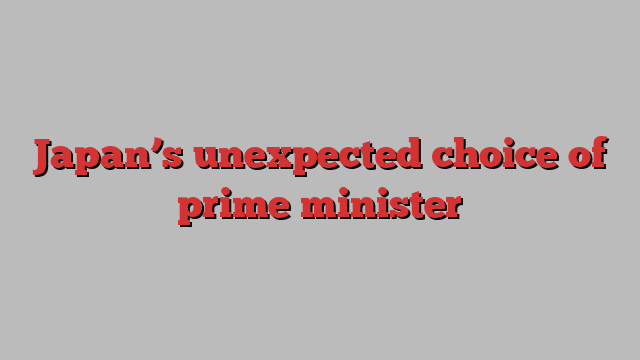
Unlock the Editor’s Digest for free
Roula Khalaf, Editor of the FT, selects her favourite stories in this weekly newsletter.
In electing a new prime minister, Japan’s ruling Liberal Democratic party could have opted for generational change in the form of 43-year-old Shinjiro Koizumi. It could have chosen a return to the nationalistic conservatism of former leader Shinzo Abe — and with it a first female prime minister — in the shape of Sanae Takaichi. Instead it went through door number three, an unexpected one, and selected 67-year-old Shigeru Ishiba, something of an outsider within his own party, who triumphed and won the top job at the fifth time of asking.
Ishiba is widely respected as an expert in defence policy and an honest, conscientious leader who is close to his rural constituents in Tottori prefecture. He has served as minister of defence and minister of agriculture, among other posts. Yet he is a singular figure, more popular with the public than with his parliamentary colleagues, who has spent the past decade sitting outside the main currents of Japanese politics. On economics, on the US-Japan alliance and in the management of his own party, some of Ishiba’s past positions will make it harder to run a successful administration. The new prime minister has his work cut out for him.
Ishiba’s most immediate challenge will be to form a cabinet. Given his enmity with power brokers such as former prime minister Taro Aso, it will be tricky to get the balance right. Ishiba’s path to victory relied on support from regional party members, who catapulted him into a run-off among parliamentarians with Takaichi, the candidate of the right. Ishiba was the second choice of enough of his fellows to emerge as a narrow victor, by 215 votes to 194, but his base of support in the parliamentary party is small. Ishiba is likely to call a general election quickly. Victory will strengthen his position. But he will have to watch his back for internal rivals at least as carefully as he handles the official opposition.
On the economy, Ishiba has signalled he will stick for now to the policies of his predecessor, Fumio Kishida, which are still, in essence, the policies of Abe. That is sensible. Ishiba favours the continued normalisation of the Bank of Japan’s monetary policy, which is desirable, provided it is consistent with keeping inflation at the 2 per cent target.
In the past, however, he was a fierce opponent of Abe’s stimulus. He has talked about raising taxes on business. He is ardently in favour of economic revitalisation for regional Japan, although how he might achieve this is unclear. None of his rhetoric is obviously supportive of economic growth. The yen rose and stock futures fell on news of his victory.
During the leadership campaign, Ishiba talked about creating an Asian Nato, presumably to defend its members against China. Yet it is not clear who, other than Japan, would want to join. He is likely, at least, to maintain Japan’s improved relations with South Korea.
Ishiba has often objected to the inequality of the US-Japan alliance, under which Washington protects Tokyo, but Japan is obliged to host US troops on its soil. It is an uneasy thought to imagine Ishiba — an earnest, serious man — discussing his desire to reshape the alliance with a mercenary, isolationist Donald Trump, should the latter regain the US presidency in a few weeks’ time.
After defeats in 2008, 2012, 2018 and 2020, Ishiba’s achievement of the premiership is a testament to the power of perseverance. His genuine personality and obvious respect for the voters give him public appeal. To succeed as the leader of a divided party, however, he will need to show a strong streak of pragmatism, at least for an initial phase, rather than pursue his own, long-held political projects.